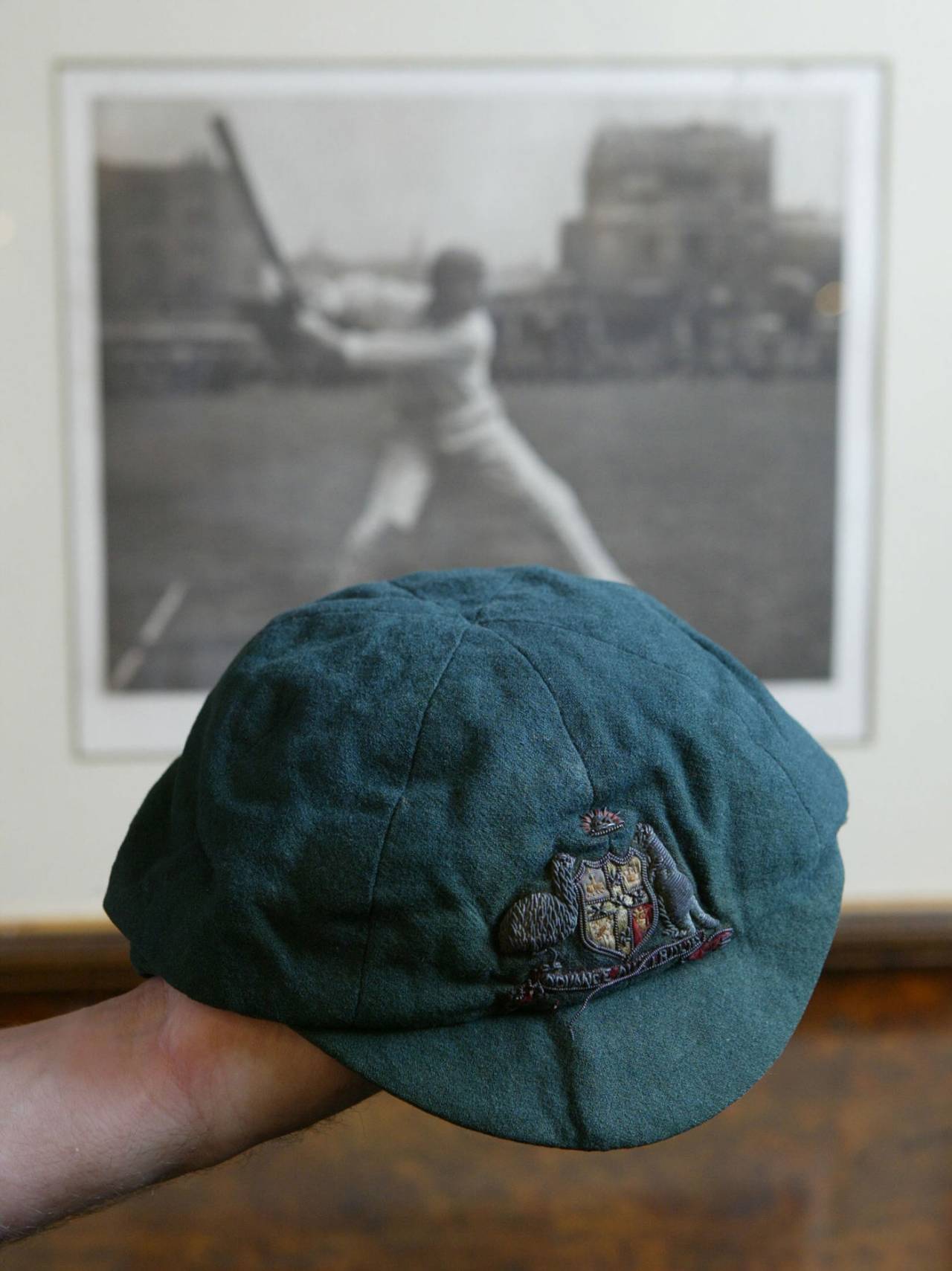Every picture tells a story
And if it's George Beldam's iconic image of Victor Trumper, it speaks volumes
Paul Edwards
30-Oct-2016

The cap that fascinates: Trumper's headgear at auction in 2004, with Beldam's image in the background • Getty Images
"He had one of those natures which called to you and in whose presence you felt it was good to live." Thus wrote Frank Iredale of Victor Trumper, his colleague on the 1899 Australian tour of England. Many contemporaries echoed Iredale's sentiments and in the 101 years since Trumper's death from Bright's disease, his reputation has grown to legend. Cricket writers have strived and sometimes strained to express their admiration of his batsmanship yet none of them come close to that picture in capturing the elusive magic.
George Beldam's 1905 image "Jumping out for a straight drive" is surely the most famous photograph in the history of cricket. Certainly it is the most reproduced, for it has appeared on the covers of countless books and on letterheads and posters; it has been sculpted, etched, reprinted and woven; it has even been the symbol for an internet chat room.
And in 1975 it appeared on page 89 of Great Australian Cricket Pictures, where it first came to the notice of a young Gideon Haigh. Thus began a 40-year fascination with Trumper that has culminated in Stroke of Genius, which in the author's words is "an iconography, a study of Trumper's valence in cricket's mythology and imagery".
It could be argued that Haigh has sold himself a little short there. For his latest book is more than a study in polysemy and its related fields, invaluable though that is. Stroke of Genius includes passages on the early history of photography, the development of cricket in Australia and the changing ways in which Australian writers like Jack Fingleton viewed the game. And it is perhaps appropriate that a cricketer whose method was exclusively his own is the chief subject of a book that defies easy classification.
But if the librarians at Lord's or the MCG are uncertain as to which section Stroke of Genius properly belongs, there need be no doubt about its quality. This may be the book Haigh was destined to write, and he has not been overawed by the occasion. While one might quibble at the absence of an index, one enjoys everything else.
It is not only Haigh's familiarity with his material that makes this book a triumph. He has three qualities rarely found in conjunction: he is a very good scholar, a very fine writer, and he also understands that what he describes is often best understood in its wider non-cricketing context.
The sections in the book where these skills were most interestingly in evidence, at least to this reviewer, were those on photography. Again this is only fitting given that the centrepiece of the book is that wonderful moment of incipience captured by Beldam 111 years ago. Haigh begins the relevant chapter with a quotate from Emile Zola that could serve as an epigraph to the whole book.
"I don't think you can really say you have seen something until you have taken a photograph of it, which reveals all the details you would not otherwise have noticed - and which in most case cannot even be seen."
Soon afterwards the reader is learning about gelatine emulsions, focal-plane shutters and the other innovations by which Beldam sought to refine photographic technique, and that would lead to the production of Great Batsmen: Their Methods at a Glance, which was published with text by CB Fry in 1905 and which included the famous image of the best batsman in the world at that time. Thus an English photographer, who like Trumper followed his own method, helped preserve the powerful image that was used as Australia sought to free itself from colonial associations and establish its independence.
"Trumper lifted [cricket] to a level of art beyond the reach of all but himself," wrote Bede Nairn in the Australian Dictionary of Biography. "And, in achieving this, he reworked the charter of cricket from a Victorian artefact into an Edwardian palimpsest, with spacious Australian flourishes all but replacing the English script."

Getty Images
The nature and variety of further Australian "flourishes" inspired by Trumper, a few of them rather eccentric, are carefully chronicled by Haigh in this rich and rewarding book. So rewarding, indeed, that one wonders whether another edition might be published, rather following the example of Edmund de Waal's wonderful The Hare with the Amber Eyes, in which all the photographs, some of which seem a trifle cramped in the current version, could be reproduced in full clarity.
That, though, is another cavil at excellence. For the moment, anyone remotely interested in why players like Steve Waugh were so interested in the style of cap worn by Trumper can do no better than buy Haigh's book. It will take them back to that glorious image of an Australian cricketer who took the art of batting and reinvented it after his own fashion.
"You know that photograph. It just sits in your mind and your memory", said former Australian prime minister Kevin Rudd on dedicating the SCG's Trumper Stand in December, 2008. Yes, that's right, it really does. Get the modest acceptance speeches ready, Gideon. This is the cricket book of the year.
Stroke of Genius
by Gideon Haigh
Penguin Australia, 2016
A$39.99
by Gideon Haigh
Penguin Australia, 2016
A$39.99